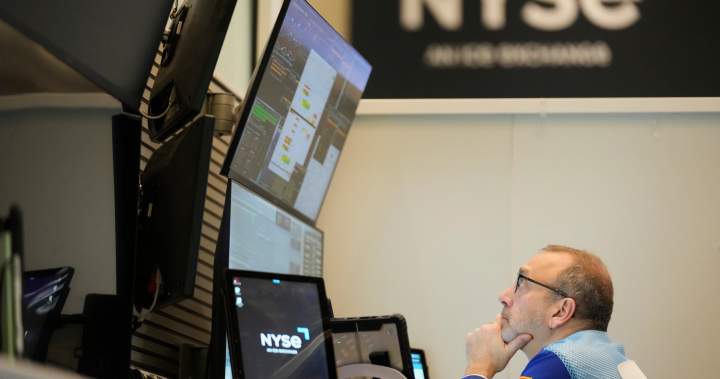Physical Address
304 North Cardinal St.
Dorchester Center, MA 02124
Physical Address
304 North Cardinal St.
Dorchester Center, MA 02124

U.S. indexes bounced between gains and losses on Tuesday and ended mixed Wall Street how Trade tensions continued to flare between Washington and Beijing.
Canada’s main S&P/TSX stock index soared, meanwhile, to finish more than 500 points higher at 30,353.61, helped by strong gains in the basic materials sector.
In the US, the S&P 500 closed 0.2% lower after switching between a sharp morning loss and an afternoon recovery. The Dow Jones Industrial Average rose 0.4% and the Nasdaq composite fell 0.8% after making similar changes. The moves mark another series of sharp turns for markets in recent days.
Wall Street fell on Friday for its worst day since April and rebounded on Monday for its best day since May. The changes were prompted by changing trade sentiment between the United States and China.
The latest move follows China’s Commerce Ministry banning Chinese companies from dealing with five subsidiaries of South Korean shipbuilder Hanwha Ocean, and defying President Donald Trump’s efforts to rebuild the industry in America. European markets were mixed and Asian markets fell.
Overall, the S&P 500 fell 10.41 points to 6,644.31. The Dow Jones Industrial Average rose 202.88 points to 46,270.46, and the Nasdaq sank 172.91 to 22,521.70.
Technology stocks are particularly sensitive to trade issues involving China and were the market’s biggest weights. Major chipmakers and other companies rely on China for raw materials and manufacturing. China’s large consumer base is also important for sales growth. Chipmaker Nvidia fell 2.6% and Broadcom fell 3.5%.
The ongoing trade war between the United States and the world has been an unpredictable weight on the market. The trade conflict between the United States and China is potentially the most economically consequential, due to the positions of these nations as the two largest economies in the world.
International shipping and shipbuilding became a major source of friction between Washington and Beijing, with each side imposing new port fees on the other’s ships. Those fees went into effect Tuesday.
“We remain cautiously optimistic that both sides will eventually seek a negotiated resolution, given the significant economic stakes,” said Ulrike Hoffmann-Burchardi, Americas chief investment officer and global head of equities at UBS Global Wealth Management.

Get expert insights, questions and answers on markets, housing, inflation and personal finance information every Saturday.
The US economy has so far dodged any major impact from the frequently changing US tariff policies. That could change if nations fall back into a cycle of retaliatory tariffs and companies pass more of the higher costs on to consumers.
The US government shutdown ended the usual economic updates on inflation, consumer spending and employment. That has made it difficult for investors and economists to continue assessing the economic impact of the tariffs. Wall Street is looking to the company’s latest round of earnings and forecasts to get a better sense of the broader economic picture.
The upcoming earnings reports will also help Wall Street gauge the value of the broader market amid criticism that it has become too expensive after prices rose much faster than corporate profits. For stocks to look less expensive overall, prices must fall or corporate profits must rise.
Banks were the first major sector to release the latest round of earnings reports and the results suggest Wall Street has had one of its most profitable quarters ever. Even so, the managers of the main banks expressed various degrees of caution about the markets and the economy. JPMorgan Chase fell 1.9%, Wells Fargo rose 7.1% and Citigroup rose 3.9%.
Industrial companies and retailers were among the other companies that made some of the biggest gains. Caterpillar rose 4.5% and Walmart rose 5%.
Shares of Beyond Meat fell 24.6% to below $1 as investors worried about the company’s plans to reduce its debt by issuing more shares.
The lack of updates on the US economy has also left the Federal Reserve without much of the information it uses to make policy decisions. The central bank cut its benchmark interest rate by a quarter of a percentage point in September amid concerns that unemployment could worsen. That marked its first cut of the year, and Wall Street expects similar cuts at Fed meetings in October and December.
The lack of employment and inflation data makes it difficult for the central bank to balance its tasks of helping to maintain strong employment and keeping prices stable. On Tuesday, Fed Chairman Jerome Powell signaled again that the Fed is a bit more concerned about the labor market.
“The increased downside risks to employment have changed our assessment of the balance of risks,” he said at a meeting of the National Business Economics Association in Philadelphia.
Treasury yields remained relatively stable. The yield on the 10-year Treasury yield fell to 4.03% from 4.05% on Friday. Bond markets were closed on Monday in the United States for the holiday.
Gold rose 0.7% and remains above $4,100 an ounce. The precious metal has soared 57% in 2025 amid a long list of uncertainties, including tariffs and the economy.
AP writers Yuri Kageyama, Matt Ott and Christopher Rugaber contributed to this report. Additional files from the Canadian Press
© 2025 The Canadian Press

